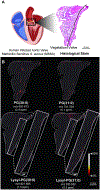Visualizing Staphylococcus aureus pathogenic membrane modification within the host infection environment by multimodal imaging mass spectrometry
- PMID: 35654040
- PMCID: PMC9308753
- DOI: 10.1016/j.chembiol.2022.05.004
Visualizing Staphylococcus aureus pathogenic membrane modification within the host infection environment by multimodal imaging mass spectrometry
Abstract
Bacterial pathogens have evolved virulence factors to colonize, replicate, and disseminate within the vertebrate host. Although there is an expanding body of literature describing how bacterial pathogens regulate their virulence repertoire in response to environmental signals, it is challenging to directly visualize virulence response within the host tissue microenvironment. Multimodal imaging approaches enable visualization of host-pathogen molecular interactions. Here we demonstrate multimodal integration of high spatial resolution imaging mass spectrometry and microscopy to visualize Staphylococcus aureus envelope modifications within infected murine and human tissues. Data-driven image fusion of fluorescent bacterial reporters and matrix-assisted laser desorption/ionization Fourier transform ion cyclotron resonance imaging mass spectrometry uncovered S. aureus lysyl-phosphatidylglycerol lipids, localizing to select bacterial communities within infected tissue. Absence of lysyl-phosphatidylglycerols is associated with decreased pathogenicity during vertebrate colonization as these lipids provide protection against the innate immune system. The presence of distinct staphylococcal lysyl-phosphatidylglycerol distributions within murine and human infections suggests a heterogeneous, spatially oriented microbial response to host defenses.
Keywords: MALDI imaging; Staphylococcus aureus; host-pathogen interactions; image fusion; imaging mass spectrometry; infectious disease; infective endocarditis; multimodal imaging; staph infection.
Copyright © 2022 Elsevier Ltd. All rights reserved.
Conflict of interest statement
Declaration of interests The authors declare no interests.
Figures



References
-
- Slavetinsky C; Kuhn S; Peschel A (2017). Bacterial aminoacyl phospholipids – Biosynthesis and role in basic cellular processes and pathogenicity. Biochim. Biophys. Acta – Mol. Cell Biol. Lipids 1862 (11), 1310–1318. - PubMed
Publication types
MeSH terms
Substances
Grants and funding
LinkOut - more resources
Full Text Sources
Medical

